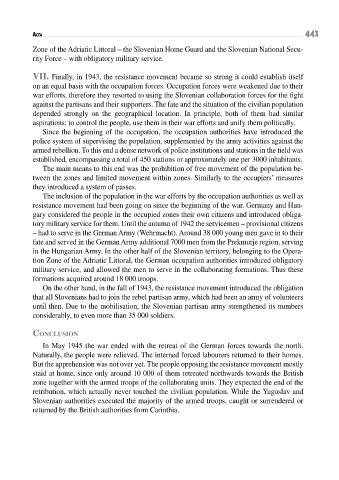Page 441 - Conflitti Militari e Popolazioni Civili - Tomo I
P. 441
441
aCta
Zone of the Adriatic Littoral – the Slovenian Home Guard and the Slovenian National Secu-
rity Force – with obligatory military service.
Vii. Finally, in 1943, the resistance movement became so strong it could establish itself
on an equal basis with the occupation forces. Occupation forces were weakened due to their
war efforts, therefore they resorted to using the Slovenian collaboration forces for the fight
against the partisans and their supporters. The fate and the situation of the civilian population
depended strongly on the geographical location. In principle, both of them had similar
aspirations: to control the people, use them in their war efforts and unify them politically.
Since the beginning of the occupation, the occupation authorities have introduced the
police system of supervising the population, supplemented by the army activities against the
armed rebellion. To this end a dense network of police institutions and stations in the field was
established, encompassing a total of 450 stations or approximately one per 3000 inhabitants.
The main means to this end was the prohibition of free movement of the population be-
tween the zones and limited movement within zones. Similarly to the occupiers’ measures
they introduced a system of passes.
The inclusion of the population in the war efforts by the occupation authorities as well as
resistance movement had been going on since the beginning of the war. Germany and Hun-
gary considered the people in the occupied zones their own citizens and introduced obliga-
tory military service for them. Until the autumn of 1942 the servicemen – provisional citizens
– had to serve in the German Army (Wehrmacht). Around 38 000 young men gave in to their
fate and served in the German Army additional 7000 men from the Prekmurje region, serving
in the Hungarian Army. In the other half of the Slovenian territory, belonging to the Opera-
tion Zone of the Adriatic Littoral, the German occupation authorities introduced obligatory
military service, and allowed the men to serve in the collaborating formations. Thus these
formations acquired around 18 000 troops.
On the other hand, in the fall of 1943, the resistance movement introduced the obligation
that all Slovenians had to join the rebel partisan army, which had been an army of volunteers
until then. Due to the mobilisation, the Slovenian partisan army strengthened its numbers
considerably, to even more than 35 000 soldiers.
cOnclusiOn
In May 1945 the war ended with the retreat of the German forces towards the north.
Naturally, the people were relieved. The interned forced labourers returned to their homes.
But the apprehension was not over yet. The people opposing the resistance movement mostly
staid at home, since only around 10 000 of them retreated northwards towards the British
zone together with the armed troops of the collaborating units. They expected the end of the
retribution, which actually never touched the civilian population. While the Yugoslav and
Slovenian authorities executed the majority of the armed troops, caught or surrendered or
returned by the British authorities from Carinthia.

